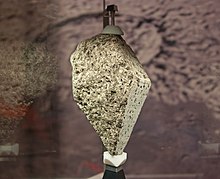LUNAR ROCK

Olivine basalt collected by Apollo 15.
Job 18:4
You who tear yourself to pieces in your anger, is the earth to be abandoned for your sake? Or must the rocks be moved from their place?
Moon rock or lunar rock is rock that is found on the Earth's moon, or lunar material collected during the course of human exploration of the Moon.
Moon rocks on Earth come from three sources: those collected by the US Apollo manned lunar landings from 1969 to 1972; samples returned by three Soviet Luna unmanned probes in the 1970s; and rocks that were ejected naturally from the lunar surface by crateringevents and subsequently fell to Earth as lunar meteorites. During the six Apollo landing missions, 2,415 samples weighing 380.96 kilograms (839.87 lb) were collected. Three Luna spacecraft returned with an additional 326 grams (11.5 oz) of samples. Since 1980, over 120 lunar meteorites representing about 60 different meteorite fall events (none witnessed) have been collected on Earth, with a total mass of over 48 kilograms (106 lb).About one third of these were discovered by US and Japanese teams searching forAntarctic meteorites (e.g., ANSMET), with most of the remainder having been discovered by collectors in the desert regions of northern Africa and Oman.
Rocks from the Moon have been measured by radiometric dating techniques. They range in age from about 3.16 billion years old for thebasaltic samples derived from the lunar maria, up to about 5.3 billion years old for rocks derived from the highlands. Based on the age dating technique of "crater counting," the youngest basaltic eruptions are believed to have occurred about 1.2 billion years ago,but scientists do not possess samples of these lavas. In contrast, the oldest ages of rocks from the Earth are between 3.8 and 4.28 billion years old.
Almost all lunar rocks are depleted in volatiles and are completely lacking in hydrated minerals common in Earth rocks. In some regards, lunar rocks are closely related to Earth's rocks in their isotopic composition of the element oxygen. The Apollo moon rocks were collected using a variety of tools, including hammers, rakes, scoops, tongs, and core tubes. Most were photographed prior to collection to record the condition in which they were found. They were placed inside sample bags and then a Special Environmental Sample Container for return to the Earth to protect them from contamination. In contrast to the Earth, large portions of the lunar crust appear to be composed of rocks with high concentrations of the mineral anorthite. The mare basalts have relatively high iron values. Furthermore, some of the mare basalts have very high levels of titanium (in the form ofilmenite).


Comments
Post a Comment